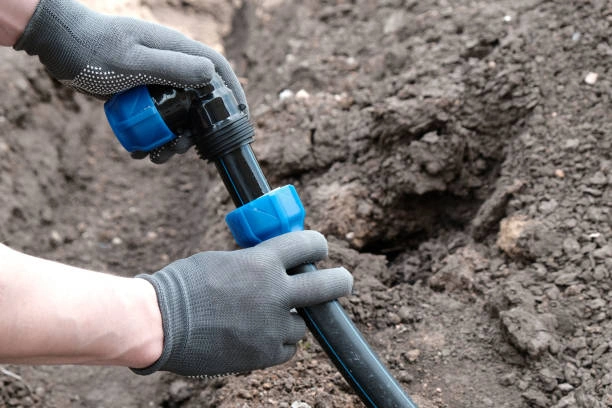Introduction
HDPE (High-Density Polyethylene) fittings have become essential components in modern piping systems due to their durability, chemical resistance, and ease of installation. Whether you’re working on residential plumbing, industrial applications, or municipal water systems, selecting the right HDPE fittings is crucial for creating leak-proof, long-lasting connections. This guide will help you understand the different types of HDPE fittings and how to choose the best ones for your project.
Key Takeaways:
✔ Main types of HDPE fittings and their applications
✔ Material grades (PE80 vs PE100) comparison
✔ Pressure and temperature specifications
✔ Proper installation techniques
✔ Answers to common questions
Why Choose HDPE Fittings?
HDPE fittings offer significant advantages over traditional materials:
✅ Superior Durability – Resistant to corrosion, chemicals, and UV radiation
✅ Flexible Design – Accommodates ground movement and seismic activity
✅ Leak-Free Connections – Heat-fused joints create permanent seals
✅ Long Service Life – 50+ years of reliable performance
✅ Eco-Friendly – Made from recyclable materials with low environmental impact
Types of HDPE Fittings
1. Butt Fusion Fittings
- Best for: Permanent, high-pressure systems
- Advantages: Strongest connection type, seamless joints
- Considerations: Requires specialized fusion equipment
2. Electrofusion Fittings
- Best for: Repairs and hard-to-reach areas
- Advantages: Precise connections, built-in heating elements
- Considerations: Higher per-unit cost
3. Mechanical Fittings
- Best for: Temporary systems or quick repairs
- Advantages: No heat required, easy installation
- Considerations: Not recommended for permanent installations
4. Flange Adapters
- Best for: Connecting HDPE to other pipe materials
- Advantages: Handles high vibration/pressure
- Considerations: Requires proper gasket installation

Selecting the Right HDPE Fitting
1. Material Grade Selection
- PE100: Higher density for demanding applications (industrial, gas)
- PE80: Standard grade for residential water systems
2. Size and Pressure Requirements
- Match fitting size to pipe diameter (common sizes: 20mm to 400mm)
- Verify pressure rating (PN ratings indicate maximum pressure capacity)
3. Application-Specific Considerations
- Potable Water: Use NSF-certified fittings
- Chemical Transport: Select chemical-resistant materials
- Underground Use: Choose UV-stabilized fittings if exposed
Installation Best Practices
1. Preparation
- Gather necessary tools (pipe cutter, fusion machine, cleaning supplies)
- Ensure work area is clean and dry
2.Pipe Preparation
- Cut pipe square using a dedicated pipe cutter
- Remove all burrs and clean pipe ends thoroughly
3.Fitting Installation
- For fusion fittings: Follow manufacturer’s heating/cooling times
- For mechanical fittings: Tighten to specified torque values
4. System Testing
- Conduct pressure test at 1.5x operating pressure
- Inspect all connections for leaks
Comparing HDPE to Other Materials
Performance Factors
- Longevity: HDPE lasts decades longer than PVC or metal
- Chemical Resistance: Superior to both metal and PVC
- Installation: More complex than PVC but offers better long-term reliability
- Cost: Higher initial cost than PVC but lower lifecycle cost
Application Suitability
- Water Systems: HDPE outperforms both alternatives
- Gas Lines: HDPE is superior to PVC (which can’t be used)
- Chemical Transport: Better than metal for most applications
5 Essential FAQs
1. What’s the temperature limit for HDPE fittings?
Standard HDPE fittings can handle continuous temperatures up to 60°C (140°F), with special formulations available for higher temperatures.
2. Can HDPE fittings be used for gas lines?
Yes, when using properly certified fittings and following local regulations.
3. How do I connect HDPE to existing metal pipes?
Flange adapters or transition fittings provide secure connections between different materials.
4. What’s the difference between PE80 and PE100?
PE100 has higher density and pressure capacity, while PE80 is more flexible and cost-effective.
5. Are HDPE fittings recyclable?
Yes, HDPE fittings can be recycled at specialized facilities at the end of their service life.
Conclusion
Selecting the right HDPE fittings requires understanding your project’s specific needs:
- Permanent systems benefit from fusion fittings
- Temporary installations can use mechanical fittings
- Challenging environments need high-grade PE100 materials
By choosing quality HDPE fittings and following proper installation techniques, you’ll create piping systems that deliver decades of reliable, leak-free service.
Need professional advice? Consult with an HDPE piping specialist for your specific application requirements.

















![PE Pipe Market Size, Share, Trend [2024-2032] Forecast Report PE pipe](https://pipefittingblog.com/wp-content/uploads/2024/10/bd6eee761609250b2b9f3b286372274c.webp)
